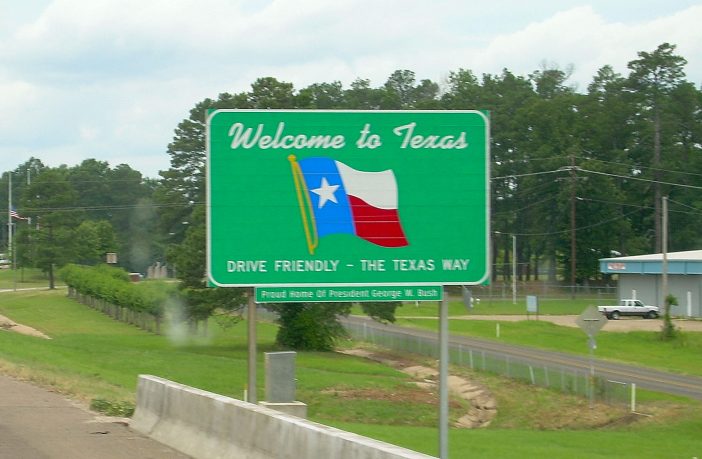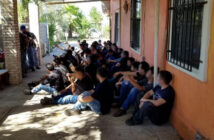It has often been said, in particular by critics of border closures and travel restrictions during the ongoing COVID-19 crisis, that “viruses don’t respect borders.” While there may be some validity to that assertion, in the most literal sense, it is difficult to deny that closing borders and limiting travel plays a role in limiting virus spread. After all, it keeps carriers, or potential carriers, from spreading the contagion by traveling or crossing the frontiers of other nations.
The real problem emerges when border closures and travel bans are half-measures riddled with numerous loopholes and exceptions – which both undermines the effectiveness of closing borders and restricting travel, and allows the open-borders crowd to claim that such measures don’t really work. A case in point may be evidence suggesting that Mexico’s coronavirus peak is spilling over into counties on the U.S. side of the border.
Although the Trump administration restricted all “non-essential” traffic – including tourism and recreational travel – along the U.S.-Mexico border as of March 21, commerce and other traffic deemed essential continued. However, U.S. citizens (including dual ones), permanent legal residents (i.e. “green card” holders), and “certain other travelers” – including those seeking medical care – were exempted from the ban. While that might have made sense from a legal, economic, and even humanitarian perspective, it made less sense from a public health one. These exceptions created loopholes that the coronavirus could – and did – exploit.
Although a few media outlets have written about the spike in COVID-19 cases in border counties along the U.S.-Mexico frontier, a series of articles written over the past month by Daniel Horowitz of Conservative Review is perhaps the most enlightening.
As Horowitz argues, “the [corona]virus seems to have come to western Mexico first in Baja California (south of California), then migrated east to Sonora (south of Arizona) in May and then to Tamaulipas (south of Texas) in June.” This trend, according to Horowitz, was consistent with both spikes in border apprehensions and sharp increases in California, Arizona, and Texas border county COVID-19 cases.
He further points out that (as of July 19), in the case of Texas, for example, border counties accounted for 42 percent of the state’s reported COVID-19 deaths – in spite of constituting only 9 percent of Texas’ population and having much less population density than the counties closer to major cities.
How coronavirus-infected individuals seeking medical help on the U.S. side of the border contributed to community spread is at this point unknown. The possibility of infecting others while being transported the nearest hospital may be minimal, but there is always a chance for nosocomial (i.e. hospital) spread.
What we do know is that when a coronavirus patient arrives from Mexico and dies in a U.S. hospital, his/her death increases hospitalization and death statistics in the border counties (and states). And then there are the large numbers of people traveling back and forth between the two countries, at least some of whom may have brought in COVID-19 “silently.” This makes the potential for spreading this highly contagious disease greater than if cross-border traffic was more restricted.
Had the reopening of Texas, which occurred on May 1, been primarily responsible for the coronavirus surge – as the mainstream media has claimed – then surely the more densely-populated urban areas would have been hit harder than the border counties, Horowitz argues.
Take Hidalgo County, Texas (the McAllen area), for example. There “deaths actually went down to near zero from mid-May to mid-June – right during the window you would typically see those deaths occur, had the reopening played a role.” However, “the surge in deaths beginning in late June coincides with the peaking of deaths in Mexico, particularly in Tamaulipas, right during the beginning of June, which perfectly jives with the 21-day average infection-to-death duration.”
Hospital administrators in Texas, especially in the border area, admit that they are being inundated with many patients from Mexico. For instance, Horowitz quotes Dr. Ivonne Lopez, medical director of McAllen Hospital Group at McAllen Medical Center, who stated that:
“One of the factors is the border, we in McAllen Medical are receiving many patients from Mexico, they are coming in because their resources over there are also limited so they are coming into our area seeking medical attention and by law we have to provide it. The patients that cross the border say ‘we don’t have hospital space over there, the oxygen is gone, we don’t have medications so we cross the border,’ that’s the situation in the border.”
Are these patients U.S. citizens, dual citizens, green card holders, or illegal aliens? We do not know for sure, mainly because, as Todd Bensman of the Center for Immigration Studies (CIS) points out, “no one will ask or say where the patients originated or even attempt to break things down.”
However, a registered nurse from southern California stated in a YouTube interview that “a lot of them are Spanish-speaking only. What I do know is what my patients said, a lot of them are coming over the border and going to the hospital and they’re flying them from that hospital.” No doubt the situation is similar in southern Texas.
What is more, the travel restrictions at the southern border are being enforced in a rather lax manner. Nor were border crossers subject to proper medical screening. One anonymous veteran southwest Texas customs officer told Horowitz’s Conservative Review, “At the inception of the nonessential travel ban, CBP [Customs and Border Patrol] officers have been told by management that it is none of their business if the travelers are traveling for essential purposes and if they are wearing proper [Personal Protective Equipment].”
“Hundreds of Mexicans cross daily claiming their travel is considered as trade and commerce because they simply provide a typed letter of employment with a fancy letterhead and a Mexican-made employment identification card. CBP officers have had no formal training about such Mexican documents other than the Mexican passport,” the agent told Horowitz.
He continued, “CBP officers suspect many of these letters of employment and employment identification cards are fraudulent, but management continues to allow them to enter without the proper vetting. As a result, traffic has increased drastically since the nonessential travel ban.”
Given the COVID-19 situation in the border region, it is clearly necessary to tighten the enforcement of travel restrictions and limit the loopholes. Some of the solutions offered by Horowitz are, in particular, blocking or limiting trips for medical care, mandatory quarantines for anyone traveling between the U.S. and Mexico, and perhaps -if the Mexican government requests it – also helping set up field hospitals on the Mexican side of the border to alleviate the situation on the southern side of the Rio Grande (which could treat U.S. citizens, permanent residents, and others without the need of bringing them across the border).
Moreover, “green card holders should never have been allowed to come in while Americans are locked down. Even dual citizens should have just been given the option to come in one time at the beginning, not to travel back and forth in middle of the epidemic.”
If we fail to implement the above common-sense measures, Mexico’s coronavirus peak will continue exacerbating the COVID-19 situation in the southwestern border states, Texas in particular. National borders are an important weapon in the fight against a virus that originated in China, and we should not nullify their effectiveness through half-measures and excessive, overly-broad exceptions.




